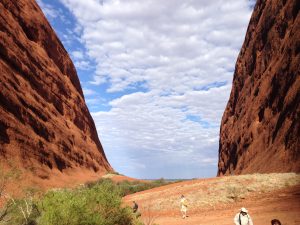Did you know that each year, over 250,000 people make the trek to the Red Centre to visit Kata Tjuta and Uluru? While a portion of that impressive number is Australian, many visitors journey worldwide to witness these amazing natural icons! And while some overseas visitors may come primarily to experience the world-famous Uluru, we know that those who also visit Kata Tjuta leave with memories they will never forget.
If a trip to the Red Centre is on your schedule, SEIT offers a five-hour fully guided tour to Kata Tjuta. And for those planning the big journey, knowing more about Kata Tjuta will make your experience that much more enjoyable and enlightening. Here are five things you should know before visiting Kata Tjuta.
1. The (Recent) History of Kata Tjuta
In 1872, a year before the initial European sighting of Uluru, Ernest Giles became the first European to spot Kata Tjuta in the distance. However, Lake Amadeus (Pantu in the local Indigenous language, Pitjantjatjara) barred him at the time from coming closer.
It was Giles who named the tallest dome Mount Olga, after Queen Olga of Württemberg; to European settlers, Kata Tjuta subsequently became known as The Olgas.
In late 1993, however, the dual name was culturally recognised, with Mount Olga renamed Mount Olga/Kata Tjuta until 2002, when the names were reversed – in recognition of the traditional owners –
to Kata Tjuta/Mount Olga. 1993 also saw the park in which Uluru and Kata Tjuta reside renamed from its European name to Uluru-Kata Tjuta National Park.
First listed as a World Heritage site in 1987, Uluru-Kata Tjuta National Park has played a vital role in attracting tourists to the Red Centre from interstate and overseas – as the numbers show! But its cultural significance to the local Anangu people, and generations of Australian Aboriginal people, is even more notable.
2. Kata Tjuta’s Significance to the Anangu People

In the thousands of years before European settlement, the Anangu people, the traditional owners of Uluru-Kata Tjuta National Park, established a rich history with their land. Their basis of culture and way of life, known as Tjukurpa (traditional law), views the people and the land as being one and, therefore, inseparable. For this reason, what became known as “Handback” in 1985, wherein the government formally recognised Anangu ownership of the park and handed over the title deeds, was significant to the traditional owners.
Like Uluru, Kata Tjuta is culturally sacred to the Australian Aboriginal people, with stories of their creation and subsequent importance passed down from generation to generation. According to Anangu culture, Uluru and Kata Tjuta date back to the dawn of time, when they were formed by ancestral beings.
For those interested in learning more about the relationship between the Anangu people and Kata Tjuta and its cultural importance, our SEIT Kata Tjuta tour is available all year round!
3. Kata Tjuta: A Place to Call Home for Many Animals and Plants
Along with learning about the history of Kata Tjuta, visiting these famous domes will also offer you the chance to see some iconic Australian wildlife. In fact, nearly three hundred species of wildlife call Uluru-Kata Tjuta National Park home, including 178 birds, 21 mammals, three frogs and 73 reptiles!
Some of our favourite fauna to spot in the park are the zebra finch, the Spinifex hopping mouse, and the thorny devil, three small and unique species our guides will be sure to point out on your tour. And, of course, the park is also home to two Aussie icons known worldwide, kangaroos and dingoes! Don’t forget your camera, because every animal in the park – even the little ones if you can get close enough without disturbing them – makes for a great photograph to show your friends back home.
You will also want to have your camera ready when taking in the unique beauty of the domes and the surrounding landscape.
The Red Centre is part of a desert, but don’t be fooled into thinking the land is completely arid. The park itself boasts over 400 different species of fauna, making it a memorable visit for nature lovers! We suggest keeping an eye out for the Sturt’s desert rose, the official floral emblem of the Northern Territory.
4. Kata Tjuta Is Bigger Than You Might Think!
Kata Tjuta translates to “many heads”, a fitting name considering its geological makeup of thirty-six domes!
This iconic Australian landmark is also far bigger than it might look in the pictures, with the tallest of these domes, Mount Olga, reaching 1066 metres above sea level and 546 metres above its surrounding land. Overall, Kata Tjuta also spans an area of 21 square kilometres.
For comparison, Uluru reaches 863 metres above sea level and has a perimeter of 9.4 kilometres. Both, however, are truly impressive in person–but if you think a quick visit will suffice, it would be best to set aside some extra time, given their size!
5. How Do I Get Around at Kata Tjuta?

The two main walking areas at Kata Tjuta are Walpa Gorge walk and Valley of the Winds. If you have the time, both are worth the visit.
If you are looking for a more accessible experience, we recommend the Walpa Gorge walk, which takes about an hour to finish. During your journey, you will also venture through Kata Tjuta’s two tallest domes, a stunning sight that will have you reaching for your camera. And for those nature lovers, the area is rife with plenty of flora and fauna, including the common wallaroo!
The Valley of the Winds, while just as spectacular, is ultimately the more challenging (and steep) walk of the two. We suggest you wear sturdy shoes, be careful and don’t rush as you make your way along the sometimes rocky terrain. Overall, this walk takes between three and four hours to complete, but the views from the two lookouts (Karu and Karingana) are so incredible that you will be glad you put in all that effort!
For those interested in a guided tour, our SEIT Valley of the Winds tour lasts five hours and includes morning tea, pickup, and return from Ayers Rock Resort.

